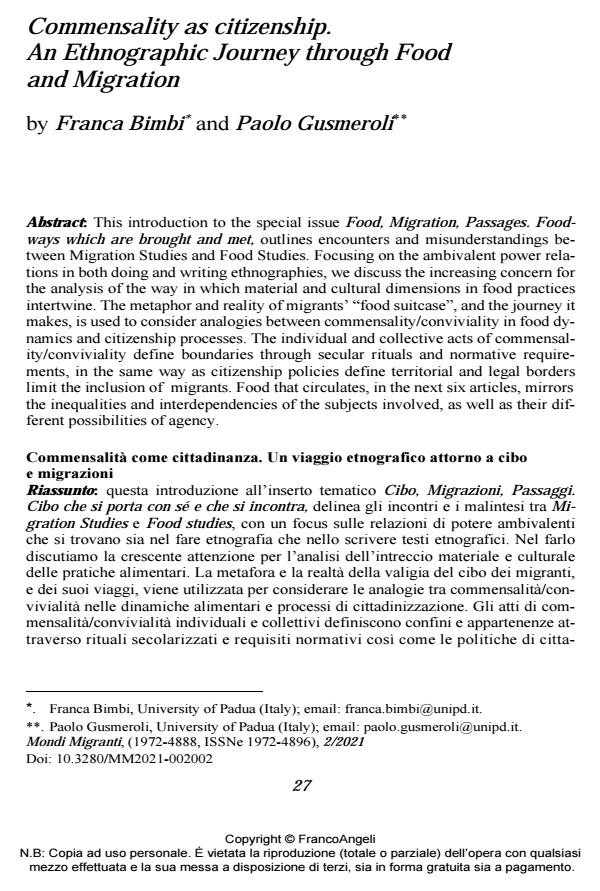Commensality as citizenship. An Ethnographic Journey through Food and Migration
Titolo Rivista MONDI MIGRANTI
Autori/Curatori Franca Bimbi, Paolo Gusmeroli
Anno di pubblicazione 2021 Fascicolo 2021/2
Lingua Inglese Numero pagine 28 P. 27-54 Dimensione file 305 KB
DOI 10.3280/MM2021-002002
Il DOI è il codice a barre della proprietà intellettuale: per saperne di più
clicca qui
Qui sotto puoi vedere in anteprima la prima pagina di questo articolo.
Se questo articolo ti interessa, lo puoi acquistare (e scaricare in formato pdf) seguendo le facili indicazioni per acquistare il download credit. Acquista Download Credits per scaricare questo Articolo in formato PDF

FrancoAngeli è membro della Publishers International Linking Association, Inc (PILA)associazione indipendente e non profit per facilitare (attraverso i servizi tecnologici implementati da CrossRef.org) l’accesso degli studiosi ai contenuti digitali nelle pubblicazioni professionali e scientifiche
This introduction to the special issue Food, Migration, Passages. Foodways which are brought and met, outlines encounters and misunderstandings between Migra-tion Studies and Food Studies. Focusing on the ambivalent power relations in both doing and writing ethnographies, we discuss the increasing concern for the analysis of the way in which material and cultural dimensions in food practices intertwine. The metaphor and reality of migrants’ "food suitcase", and the journey it makes, is used to consider analogies between commensality/conviviality in food dynamics and citizenship processes. The individual and collective acts of commensali-ty/conviviality define boundaries through secular rituals and normative require-ments, in the same way as citizenship policies define territorial and legal borders limit the inclusion of migrants. Food that circulates, in the next six articles, mirrors the inequalities and interdependencies of the subjects involved, as well as their dif-ferent possibilities of agency
questa introduzione all’inserto tematico Cibo, Migrazioni, Passaggi. Cibo che si porta con sé e che si incontra, delinea gli incontri e i malintesi tra Migration Stu-dies e Food studies, con un focus sulle relazioni di potere ambivalenti che si trova-no sia nel fare etnografia che nello scrivere testi etnografici. Nel farlo discutiamo la crescente attenzione per l’analisi dell’intreccio materiale e culturale delle pratiche alimentari. La metafora e la realtà della valigia del cibo dei migranti, e dei suoi viaggi, viene utilizzata per considerare le analogie tra commensalità/convivialità nelle dinamiche alimentari e processi di cittadinizzazione. Gli atti di commensali-tà/convivialità individuali e collettivi definiscono confini e appartenenze attraver-so rituali secolarizzati e requisiti normativi così come le politiche di cittadinanza definiscono confini territoriali e legali limitando l'inclusione dei migranti. Il cibo che circola, nei sei articoli presentati, rispecchia le disuguaglianze e le interdi-pendenze tra i soggetti coinvolti, nonché le loro diverse possibilità di agire.
Parole chiave:cibo nelle migrazioni; etnografia come pratica sociale; capitali cul-turali e abitudini alimentari; commensalità e ostipitalità.
- Cibo, religione e conflitti. La mensa scolastica come luogo d'incontro Martina Arcadu, in MONDI MIGRANTI 3/2023 pp.233
DOI: 10.3280/MM2023-003013
Franca Bimbi, Paolo Gusmeroli, Commensality as citizenship. An Ethnographic Journey through Food and Migration in "MONDI MIGRANTI" 2/2021, pp 27-54, DOI: 10.3280/MM2021-002002